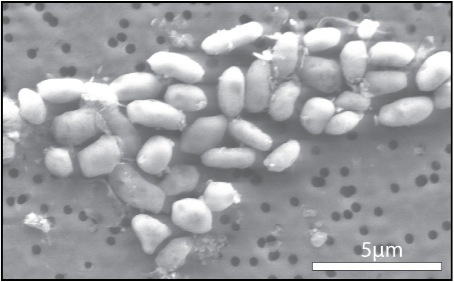Edit: A disappointing follow-up.
I spent some time this morning tracking science and nonsense in advance of NASA’s press conference on astrobiology. Now that I’ve had a chance to watch the press conference and read the Science paper, here’s a rundown on what the scientists actually found.
First off, here’s the citation and abstract for the Science paper.
A Bacterium That Can Grow by Using Arsenic Instead of Phosphorus
Felisa Wolfe-Simon, Jodi Switzer Blum, Thomas R. Kulp, Gwyneth W. Gordon, Shelley E. Hoeft, Jennifer Pett-Ridge, John F. Stolz, Samuel M. Webb, Peter K. Weber, Paul C. W. Davies, Ariel D. Anbar, Ronald S. Oremland
www.sciencexpress.org / 2 December 2010 / 10.1126/science.1197258
Life is mostly composed of the elements carbon, hydrogen, nitrogen, oxygen, sulfur and phosphorus. Although these six elements make up nucleic acids, proteins and lipids and thus the bulk of living matter, it is theoretically possible that some other elements in the periodic table could serve the same functions. Here we describe a bacterium, strain GFAJ-1 of the Halomonadaceae, isolated from Mono Lake, CA, which substitutes arsenic for phosphorus to sustain its growth. Our data show evidence for arsenate in macromolecules that normally contain phosphate, most notably nucleic acids and proteins. Exchange of one of the major bio-elements may have profound evolutionary and geochemical significance.
So first of all, this bacterium is not at all alien, nor is it evidence for a long and distinct evolutionary heritage. It’s a member of a well-known group of bacteria, the Halomonadaceae, and thus firmly placed in the standard evolutionary scheme.
Bacteria that use arsenic for respiration in the same way that we use oxygen are also not a new discovery. Scientists have known about arsenic-metabolizing bacteria for a decade or two. Drs. Felisa Wolfe-Simon and Ronald Oremland were involved in identifying arsenic-metabolizing bacteria in Mono Lake in 2008.
So why is everyone so excited?
When I was teaching introductory biology, I told my students about CHNOPS. The most abundant elements in living organisms are: Carbon, Hydrogen, Nitrogen, Oxygen, Phosphorus, Sulfur – CHNOPS. There are other trace elements necessary for life, like the iron in your hemoglobin, but those are the big six and everything needs them.
Or so I thought until today. These bacteria can thrive without any phosphorus at all, apparently using arsenic instead in all their biomolecules, including genetic information and metabolism.
Dr. Wolfe-Simon and her colleagues had the idea that it might be possible to substitute arsenic for phosphorus. The two elements are nearby in the periodic table, and behave similarly in reactions and compounds. (That’s what makes arsenic so poisonous to most organisms: it interferes with phosphorus use.) So she went looking, and where better than Mono Lake?
The experiment she used was both very simple and elegant. She collected bacteria from Mono Lake. It has lots of arsenic and bacteria that were already known to metabolize it. Put the bacteria in flasks with everything they need, but no phosphorus and plenty of arsenic, and see what grows. Take those, and put them in new flasks, again with arsenic and no phosphorus. Repeat for a bunch of bacterial generations, until the phosphorus that was in the bacteria when they were collected is incredibly dilute. (Not gone, unfortunately. There’s no easy way to get rid of what was originally there.)
At the end of this, Dr. Wolfe-Simon had bacteria that were living on arsenic without phosphorus, and they were doing fine. She could raise them without phosphorus, without arsenic, but not without both. And when she fractionated the arsenic bacteria — separated them into components, DNA here, proteins over there, and so on — each fraction contained tagged arsenate in the same proportion that she would have expected to find phosphate. That isn’t proof that the arsenic had substituted exactly for the phosphorus, but it is very suggestive.
Swapping out minor elements isn’t new. Octopuses have blue blood because they use copper-based hemocyanin instead of iron-based hemoglobin to transport oxygen. But these bacteria apparently have swapped out one of the major building blocks of life, something that changes our perception of the conditions under which life could be found.
This kind of switch might be beneficial in environments with low phosphorus availability, but using arsenic is inefficient. Arsenic forms weaker chemical bonds, so it takes more energy for repair and maintenance. The arsenic bacteria grew more slowly than those with phosphorus available. They also looked different: bigger, and with more open space (bigger vacuoles) inside.


Yesterday, we could have ruled out terrestrial-style life on planets without phosphorus without even looking. Today we have to check them out.
And also, I need a new intro biology book.

Neato. 🙂
Thank you for the summary!
Thanks for that synopsis. And I suspect that you’ll have to wait to get a new intro biology book until one is revised to include this new information.
I don’t teach intro biology any more, so I don’t really care. 🙂 But if I did still teach, I’d be telling my students all about this tomorrow!
And I would be telling mine about this tomorrow, but the semester is over. *NEXT* semester, however …..
BTW, what’s your take on nanobes?
I thought this was neat, but as you pointed out, a bit overblown. After all, we’ve known about organisms that use sulfur in place of oxygen for respiration (deep sea vents) although I do not believe that oxygen has been totally replaced structurally within the organisms (too much water around for that to realistically happen) So, if phosphorous can be systematically replaced by arsenic, perhaps we ought to expand our thinking and start looking for structures where silicon replaces carbon et al.
If the results of the fractionation isnt proof that the arsenic had substituted exactly for the phosphorus, what is the alternative explanation? That some molecules used both P and As? Both can form two chemical bonds and remain negatively charged at the same time, but Arsenic esters hydrolyze more easily which would render its molecules less stable. Thats probably why the GFAJ-1 substituting Arsenic were less robust. Also, do they occur naturally, or only when force fed Arsenic? Sort of like pate de foie GFAJ-1. Just curious.